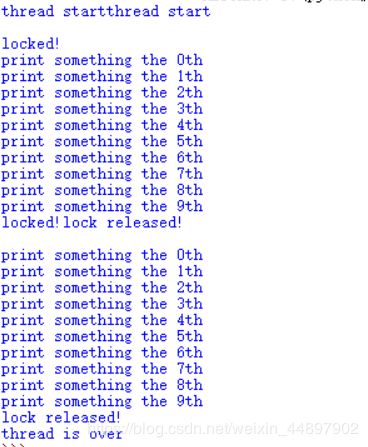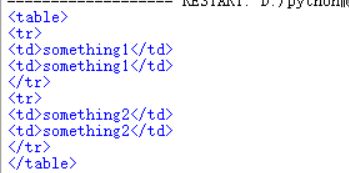python爬虫基础
欠下的帐,总有一天是要还的
在学python爬虫之前,先学习一下python的多线程
参考自
https://www.runoob.com/python/python-multithreading.html
首先调用线程,代码如下:
import thread
import time
def printf(threadname,delay):
i=1
while(i<10):
print threadname
print "this is the "+str(i)+"th"
i+=1
time.sleep(delay)
try:
thread.start_new_thread(printf,("thread-1",2))
thread.start_new_thread(printf,("thread-2",4))
except:
print "error!"
关于线程有以下几个函数:
run(): 用以表示线程活动的方法。
start():启动线程活动。
join([time]): 等待至线程中止。这阻塞调用线程直至线程的join() 方法被调用中止-正常退出或者抛出未处理的异常-或者是可选的超时发生。
isAlive(): 返回线程是否活动的。
getName(): 返回线程名。
setName(): 设置线程名。
这里就看一下run和start的使用方法:
import threading
import time
Exit=0
class Thread(threading.Thread):#继承父类threading.Thread
def _init_(self):
threading.Thread._init_(self)
def run(self):#run里写要执行的代码,线程开启后会自行调用
print "thread start"
thread_print()
def thread_print():
i=0
if Exit:
print "thread stop!"
exit()
else:
while i<10:
print "print something the "+str(i)+"th"
i+=1
thread1=Thread()#创建新线程
thread2=Thread()
thread1.start()#开启线程
thread2.start()
好了,重头戏
线程同步
使用Thread对象的Lock和RLock可以实现简单的线程同步,这两个对象都有acquire方法和release方法,话不多说,看代码
这是不加锁时的执行结果:

import threading
import time
Exit=0
class Thread(threading.Thread):#继承父类threading.Thread
def _init_(self):
threading.Thread._init_(self)
def run(self):
print "thread start"
threadLock.acquire()#获得锁
print "locked!"
thread_print()
threadLock.release()#释放锁
print "lock released!"
def thread_print():
i=0
if Exit:
print "thread stop!"
exit()
else:
while i<10:
print "print something the "+str(i)+"th"
i+=1
thread1=Thread()
thread2=Thread()
thread1.start()
thread2.start()
threadLock=threading.Lock()#在java里应该是实例化
threads=[]
threads.append(thread1)
threads.append(thread2)
for i in threads:
i.join()
print "thread is over"
好,开始python爬虫
网上教爬虫的挺多的,也挺全的,我就记录一下自己写的吧
标题1.爬取京东电脑价格
import requests
from bs4 import BeautifulSoup
import re
for page_id in range(1,99):
url="https://search.jd.com/Search?keyword=%E7%94%B5%E8%84%91&enc=utf-8&qrst=1&rt=1&stop=1&vt=1&wq=%E7%94%B5%E8%84%91&page="+str(page_id)+"&s=241&click=0"
headers={
'User-Agent' : 'Mozilla/5.0 (Windows NT 10.0; Win64; x64; rv:68.0) Gecko/20100101 Firefox/68.0'
}
r=requests.get(url,headers=headers)
print r.status_code
content=r.text
#print content
soup=BeautifulSoup(content,'lxml')
all_1=soup.find_all('li',attrs={'class':'gl-item'})
all_2=soup.find_all('li',attrs={'class':'gl-item gl-item-presell'})
all_item=all_1+all_2
for i in all_item:
price=i.find('div', attrs={'class':'p-price'}).find('i').text
print price
标题2.爬取百度图片:
在爬取图片之前,得先了解一下lxml包
lxml.etree.HTML(text) 解析HTML文档
其中xpath和cssselect 是重点,用于获取文字和属性,功能类似与正则匹配或者beautifulsoup的find函数
例如:有一段html代码如下:
<html>
<body>
<div>
<p>there are somrthingp>
<table>
<tr>
<td>something1td>
<td>something1td>
tr>
<tr>
<td>something2td>
<td>something2td>
tr>
table>
div>
body>
html>
提取table标签,可用xpath
from lxml.html import fromstring,tostring,etree#引用fromstring和tostring是为了之后输出转成字符串
html='''
there are somrthing
something1
something1
something2
something2
'''
html_text=etree.HTML(html)
content=html_text.xpath('//div/table')[0]
content=tostring(content)#为了输出,将结果转为字符串
print content
from lxml.html import etree,tostring,fromstring
import cssselect
html='''
- a
- b
'''
html_text=etree.HTML(html)
content=html_text.cssselect('.bb')[0]
print content.text
content=tostring(content)
print content
结果如下:
![]()
好,爬图片开始!(原本想爬百度图片,但是经过长时间的试探,发现百度好像有反爬机制(当然很大可能是因为我太菜),所以这里就随便找了一个网站,来爬图片)
注意,验证路径是否匹配很重要,验证的时候可以直接在控制台输入:
$x('//div/ul/li/a/img/@src')
代码如下:
(注意路径的写法,用\\代替\)
import requests
import os
from lxml.html import etree,tostring,fromstring
import threading
ThreadLock=threading.Lock()
threads=[]
class img(threading.Thread):
def __init__(self,url,headers):
threading.Thread.__init__(self)
self.url=url
self.headers=headers
def run(self):
try:
text=self.get_pic()
print "已经获取"
self.save_pic(text)
finally:
ThreadLock.release()
def get_pic(self):
r=requests.get(self.url,headers=self.headers)
html=r.text
if r.status_code==200:
print "开始下载!"
content=etree.HTML(html)
try:
text=content.xpath('//div/ul/li/a/img/@src')
for i in text:
print i
return text
except IndexError:
print "something error"
pass
def save_pic(self,text):
j=0
for i in text:
r1=requests.get(i,headers=self.headers)
if r1.status_code==200:
print "访问正常"
print "D:\\python爬虫\\result\\%d.jpg" %j
with open("D:\\python爬虫\\result\\%d.jpg" %j,'wb') as f:
f.write(r1.content)
j+=1
print "下载完毕"
def main():
url='http://www.04832.com/6628/f390/mingrijilintianqiyubao.html'
headers={
'User-Agent':'Mozilla/5.0 (Windows NT 6.1; WOW64) AppleWebKit/537.36 (KHTML, like Gecko) Chrome/55.0.2883.87 Safari/537.36'
}
referer=url
ThreadLock.acquire()
t = img(url,headers)
t.start()
if __name__=='__main__':
main()
标题3.爬取某学校登录验证码(这个就不发代码了)
标题4.爬取小说章节(编码真的kill me)
import requests
import re
from lxml.html import etree,tostring,fromstring
import os
import io
next_url='https://www.hongxiu.com/chapter/16041863405758604/43062118761085702'
headers={
"User-Agent":"Mozilla/5.0 (Windows NT 6.1; WOW64) AppleWebKit/537.36 (KHTML, like Gecko) Chrome/55.0.2883.87 Safari/537.36",
}
k=0
html=requests.get(next_url,headers=headers)
content=html.text
text=etree.HTML(content)
title=text.xpath('//h1')[1]
print title.text
path='./result/%s'%title.text
print path
if not os.path.exists(path):
os.makedirs(path)
print "文件创建成功"
print "开始爬取"
else:
print "开始爬取"
n=int(input("需要爬取几页:"))
while(k<n):
print "第%d章"%(k+1)
url=next_url
html=requests.get(url,headers=headers)
content=html.text
if html.status_code==200:
print "访问正常"
text=etree.HTML(content)
string=text.xpath('//div/p')
next_url='https:'+text.xpath("//div[@class='chapter-control dib-wrap']/a/@href")[2]
print next_url
for i in string:
with io.open((u'%s//%d.txt'%(path,(k+1))),'a',encoding='utf-8') as f:
f.write(u'{}\n'.format(i.text))
f.close()
k+=1
print "爬取完毕"
爬取小说的时候,由于中文编码的问题,遇到以下几个报错;
1. UnicodeEncodeError: ‘ascii’ codec can’t encode characters in position 0-13: ordinal not in range(128)
最好的解决办法还是以下这种(但是这样让我原本的代码不能输出了)
import sys
reload(sys)
sys.setdefaultencoding('utf8')
2. ‘encoding’ is an invalid keyword argument for this function
这是我在调用
with open('D:\\python爬虫\\result\\%d.txt'%j,'a',encoding='utf-8') as f:
的时候报的错,修改方式如下:
import io
........
with io.open('D:\\python爬虫\\result\\%d.txt'%j,'a',encoding='utf-8') as f:
但是这样写之后又遇到这种报错
3. write() argument 1 must be unicode, not str
解决方案就是在之前加一个u,如下
f.write(u'{}\n'.format(i.text))
4.需要注意的是python用input输入之后会被当做字符串处理,所以如果输入整型,需要进行int的强转
标题5.自动提交flag(带session)
我也不知道我写的是个啥,因为没有awd环境,攻防世界的登录带验证码,不太好直接验证,就大概写个样子,反正都是带session提交
import requests
import re
headers = {
'User-Agent': 'Mozilla/5.0 (X11; Linux x86_64) AppleWebKit/537.36 (KHTML, like Gecko) Chrome/66.0.3359.139 Safari/537.36'
}
def get_flag():
url='http://111.198.29.45:36460/'
data={'username':'admin',
'password':'123456'
}
session=requests.session()
r1=session.post(url,headers=headers)
r2=session.post('http://111.198.29.45:36460/check.php',headers=headers,data=data)
if r2.status_code==200:
# print r2.text
content=r2.text
pattern = re.compile(ur'.*}')
flag=pattern.search(content).group(0)
print flag
return flag
def login():
url='http://ctf.john30n.com/login'
data={'name':'xxx',
'password':'xxx'
}
session=requests.session()
r=session.post(url,data=data,headers=headers)
return session
def auto(session,flag,ip):
url='http://xxx/submit.php'
data={
'ip':ip,
'flag':flag
}
r=session.post(url,headers=headers,data=data)
print r.text
ip=['123.123.123.123','111.111.111.111','xxxxx']
for i in ip:
flag=get_flag()
session=login()
auto(session,flag,i)



